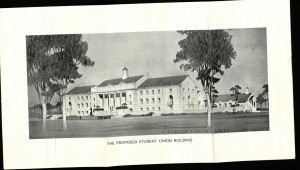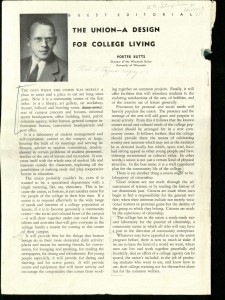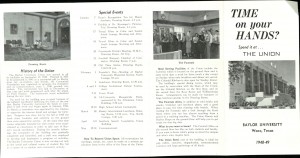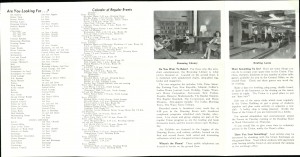By: Yolande Graham
When the idea of a student union first gained popularity on the Baylor campus among ex-students in the 1930s, the desire was to create a “social center”, “a building in which students, ex-students, and friends might enjoy the spirit of campus fellowship” (Round Up, 1945). This construction plan carried great significance because it would meet the leisure needs of a large portion of the student population that did not live in the residence halls on the Baylor campus at the time (Gray, 2014). Although the Centennial Foundation raised a lot of funds for the Union Building campaign, a lack of resources and America’s involvement in World War II put a hold on work done on the building. Construction resumed in 1946 and a few completed parts of the Baylor University Union, including the bookstore, cafeteria and club rooms, opened to the university community in 1947 (Baylor University, 1948). The Union Building was the first major building completed during the university’s post-war expansion period.
Lily Russell, who was put in charge of guiding the function and purpose of the Union Building, made deliberate decisions about its future. Russell’s intentionality in seeking guidance from universities and authors like Porter Butts along with the post-war environment, and the influx of students on the campus created an atmosphere ripe for the university expansion that would redefine access for students from that point on. The Baylor University Union provided students and the university community with new resources and opportunities that led to greater engagement and innovation on the campus.

Lily Russell Defines the Purpose of the Union Building
During the war period, Lily Russell, later the first Dean of the Union Building, reached out to a number of institutions to learn more about their student unions, how they functioned, what they looked like and what they offered to students. Russell also sought guidance from the College and University Business publication, particularly an article by guest editor Porter Butts. In a letter to Mr. J.W. Patterson inviting him to the dedication of the union building, Russell wrote: “…I think that the finest statement of the function of the Union Building is the one by Porter Butts which was published in COLLEGE AND UNIVERSITY BUSINESS some months ago… He is sort of the godfather to all the union directors in the country” (Russell, L., Russell to J. W. Patterson, October 12, 1948). Butts’ perspective on the college union would serve as a guide to Russell as she and a committee put together plans for the student engagement and activities that would occur within the Union Building when it opened.
Porter Butts-The True Purpose of a College Union
In his 1948 article, “The Union- A Design for College Living”, in College and University Business, Butts shared his pioneering view of the purpose of a college union as “a well considered plan for the community life of a college” (Butts, 1948, p. 1). To Butts, the college union was more than just another beautiful building to be constructed. It had three main roles. It was a laboratory of student management and self-expression and citizenship (Butts, 1948, p. 1). Butt explained that the union “concerned itself with the whole are of student life and interests outside the classroom, exploring all the possibilities of making study and play cooperative factors of education” (Butts, 1948, p. 1). It offered students a place to partake in all of the social aspects of their college experience such as meeting friends, dancing, reading (Butts, 1948, p. 1). The college union was a place where students could be exposed to and engage with the arts and provided “the means of cultivating worthy interests…[that] have inherent recreational and cultural value” (Butts, 1948, p. 1).
Butts believed that on top of meeting the social needs of student, the college union played a role in shaping the citizenship of its students:
Good citizens are not made through the advancement of science or by reading the history of our democratic past. Citizens are made when men begin to feel a responsibility for the general welfare; when their interests include not merely vocational matters or personal gains but the destiny of the group to which they belong. Citizens are made by the experience of citizenship (Butts, 1948, p. 1).
The space and services the college union afforded to students gave them the opportunity to test and experience, through their various involvements what it meant to be good citizens within the university and society in general. “The college has in its union a ready-made natural laboratory for the practice of citizenship, a community center in which all who will may have a part in the direction of community enterprises” (Butts, 1948, p. 1). In post-war America, this idea of citizenship seemed to resonate throughout the higher education realm as colleges all over the country began constructing their own union buildings.
Ultimately, the college union was a community space with the “job of producing students who want to use, and know how to use, their college training not for themselves alone but for the common welfare” (Butts, 1948, p. 1). It supplemented the knowledge students gained in classes and offered them a place in which to experiment with its application.

Baylor’s Purpose for the Union Building
Baylor’s stated purpose for the Union Building took a similar shape to the one described by Butts. The commitment of the Baylor University Union had both local and societal implications. Locally, it provided a space where students in between classes could “read the papers and magazines, gather informally in discussion groups, hold organization meetings, hear good music, play games, talk and in general have the opportunity for the sort of pleasant family life one finds in a good home” (“The Student Union Building”, n.d., p. 2). For ex-students it was “a central meeting place when they came to the campus, where they ay visit with friends in the lounges or during a meal in one of the several dining rooms” (“The Student Union Building”, n.d., p. 3). Societally, the union building was a part of Baylor’s solution to “many of the social problems incident to modern college life in an urban situation” (“The Student Union Building”, n.d., p. 3). It did this by “providing an attractive home base where supervised, wholesome entertainment may be had, thus reducing the natural inclination of youth to go afield, into undesirable situations if necessary, to seek their pleasures” (“The Student Union Building”, n.d., p. 3).
The Baylor University Union shifted the interests of its students and the Baylor community from one where students left campus or had nowhere to go in their leisure time to one where the community came to campus to partake of the college experience and the “unified Baylor Spirit”.
Building Beneficiaries
The Baylor University Union, once completed in 1948, cost approximately $ 900,000 to build (Baylor University, 1948). The building, which was intended to be a centennial gift to the university from ex-students, provided students with the needed space to engage in various experiences. The three-story building included a beauty parlor, a barber shop, a cafeteria that served 1,200, a full-service kitchen, reading rooms, a book store, the large lounge, a tea room, a number of dining rooms, 9 club rooms, lounges for male and female students, a bowling alley, lounges for male and female faculty, and ex-students, student council and other major all-university offices (Baylor University, 1948). The Baylor University Union not only served the needs of the Baylor community, but helped to strengthen relationships with the Waco community and other external groups.
Internal Baylor Community
The internal Baylor community made up of students, faculty and staff benefitted from the new services and spaces that the facility offered. With the post-war influx of students on campus, the university temporality used rooms in the the building as extra classroom space. For students, the Union Building was not merely new space to gather, it was a space within which they had an opportunity to shape their Baylor experiences and to prepare themselves for their futures. This involved both student initiative and administrative planning. Lily Russell, Dean of the Union Building, proposed to use the space as an etiquette training ground, through which students could be thoroughly prepared to be a part of society (Russell, L., Russell to Albert J. Rosenberg, January 18, 1950). Also on its schedule, which was within the purview of the administration (specifically Russell), students could find regular events such as Fun Nights, Singspirations, Reading Hours, Forums and special events like Dean’s Recognition dinners, Football Banquets and All-university masquerades among others (“Some Regular Events for Union Building”, p. 1).
Students also used the Union Building to host major group events like the B.S.U. Convention, Focus Week (“Report of the Dean”, 1948-1949, p. 6). Student groups had a vested interest in the functions of the building. The Gardening Club for example took charge of decorating the building for it open houses and for Christmas. They also hosted their spring flower show, the “Robert Browning Flower Festival” in the Union Building and had more than 2,000 guests in attendance, the largest up to that time (“Report of the Dean”, 1949, pp. 4-5).
Baylor’s Ex-students
The second group, Baylor’s ex-students not only gained the notoriety of having initiated and play a major role in the construction of the Union Building, but they also gained a means of staying connected to the spirit of their alma mater. In an annual report about the state of the Union Building, the then Dean of the Union Building, Lily Russell, said “They [ex-students] bring their visiting friends and relatives to see the building every day and Sunday too. They come to the fountain and cafeteria every day, they reserve our dining rooms…attend book discussions, musicals and shows” (“Report of the Dean” , 1949, p. 5). The ex-students seemed to engage more now that they had a place on campus to return to. Their engagement also served as a large public relations boost for the campus.
Those External to the Baylor Community
For the third group, all parties not directly affiliated with Baylor, the Union Building created a space for the social engagement of the community with the campus and the formation and strengthening of relationship. The dean’s report mentioned wedding receptions, “Showers, both stork and bridal”, music recitals, tea, and church meetings and receptions as some of the many activities that the outside community engaged in inside the Union (“Report of the Dean”, 1949, p. 5).
The Union also offered an opportunity to reinforce connections with Waco schools through teas held for Waco High School seniors and Waco teachers. It also offered new opportunities for religious formation through its collaboration with churches in the Waco area who hosted a number of courses, conferences and banquets in the Union Building for Baylor students to be a part of (“Report of the Dean”, 1949, pp. 5, 7).
As stated in the Union Building’s 1948-49 brochure “The Baylor University Union now [served] not only as the social and cultural center of student life, but as a center of ex-student and community activity” (“Time on your hand?” Brochure, 1948-1949). The impact that the Baylor University Union had on each of these three groups is visible in a more integrated manner when we observe what it meant across the campus.


Campus Impact of the Baylor University Union
In the post-war years, Baylor experienced a sharp increase in the number of students it admitted which affected the role that the Union played for the community. Starting in the 1945-1946 academic year, Baylor’s student body consisted of 3,205 students, but it quickly increased to 5,923 in the 1948-1949 academic year with the majority of the growth being made up of veterans (Baylor University, 1945-1946, 1948-1949). This increase in the size of the student body also result in an increase in the size of full-time faculty by 199, bringing it to the largest faculty at Baylor since its opening (Baylor University, 1948). With all of these increases, limited space became a major concern and in turn the Union became home to “42 classes, including an attendance of 1,750 students in the departments of Bible, Business, Psychology and Spanish” (Baylor University, 1948). The space concerns related to classes at the time took precedence over the defined social purpose of the building and somewhat limited the ability for the Union to function as a laboratory of student management, self-expression and citizenship.
As evident through observations of student organizations, in the Round Up starting from 1946, student involvement steadily increases in the academic and social societies. Although this cannot be credited completely to the availability of the new Union Building, this “beautiful building” gave “an incentive to activity which would be of the greatest value to them in this formative period of their lives” (“What a College Union”, n.d., p. 1).
The building of the Union also resulted in consistent, positive interactions of ex-students with the campus. As mentioned earlier, ex-students found in the Baylor University Union a place to share social experiences, to reconnect with friends and a place where “[they] expect[ed] to be received and [their] visit taken note of” (“What a College Union” , n.d., p. 3).
Conclusion
The Baylor University Union became “a college hearth around which students of the present and the past could gather in happy, comradely activity, warming their hearts by its glow” (“What a College Union”, n.d., p. 5). It helped to create system that made it easier for students, faculty, ex-students and the community to connect. It made it easier for Baylor to spread the “unified Baylor Spirit” and increase the depth of relationships it had with all of these groups.
As Baylor continued to expand near the end of the 1940s and into the 1950s with the completion of Kokernot Hall and the Armstrong- Browning Library, the Baylor University Union was able to revert to its mainly social purpose. The completion of the new Hankamer Building in 1961 enabled The Hankamer School of Business to movefrom the third floor of the Union Building, which it had occupied since late 1948 (Baylor Business, n.d.). This enabled the Union Building to reclaim this space for social use starting in the fall of 1961.
Today the Baylor University Union, renamed the Bill Daniels Student Union Building, continues to meet the social needs of students although in much different ways. In place of the cafeteria, student now have various fast food options to select from and share with their colleagues. Student organizations, though no longer designated a room in the building must work with Student Activities, located on the first floor of the Student Union Building, to have their organizations chartered. Although the function and uses of the Student Union Building at Baylor has changed with time, it has continued to be the “heart of campus” (“Connecting Through The Student Union”). The Student Union Building has continued to offer students a space in which they can express themselves, engage in formational social activities, discover new interests and engage in citizenship experiences. It is a place where “the older ex-students [dream] dreams of the noble past, [and] the students of the present [see] visons of a glorious future” (“What a College Union”, n.d., p. 5).
References
Baylor Business. (n.d.). “School History”. Retrieved from
http://www.baylor.edu/business/index.php?id=82910
Baylor University. (1945-46). Registrar Report. Waco, TX: Baylor
University.
Baylor University. (1946-47). Registrar Report. Waco, TX: Baylor
University.
Baylor University. (1947-48). Registrar Report. Waco, TX: Baylor
University.
Baylor University. (1949-49). Registrar Report. Waco, TX: Baylor
University.
Baylor University. (1948-1949). “Time on Your Hands” Brochure. BU Records: Dean of Union
Building (Lily Russell), #BU/161, Box #16, Folder #13.
The Texas Collection, Baylor
University.
Baylor University. (1948. August, 13). “ Baylor University Press Release”. Retrieved from
http://digitalcollections.baylor.edu/cdm/compoundobject/collection/tx-pr/id/1596/rec/5
Butts, P., (1948. February). “The union: A design for college living”. College and University
Business. BU Records: Dean of Union Building (Lily Russell), Accession #BU/161, Box
#16, Folder #15.
The Texas Collection, Baylor University.
“Connecting through the student union”. (n.d.). Retrieved from
http://www.baylor.edu/studentactivities/studentunion/
Garrett, Jr., J. L.(Ed.). (1945). Centennial Round Up (1845-1945). The student union building.
Retrieved from http://digitalcollections.baylor.edu/cdm/compoundobject/collection/tx-
annl/id/30594/rec/6
Gray, L. (2014). Access at Baylor 1931-1940: The student union building campaign [Web log
post]. Retrieved from https://blogs.baylor.edu/hesabaylorhistoryproject/laurens-paper/
[Report of the Dean of the Baylor University Union]. (n.d.). BU Records: Dean of Union
Building (Lily Russell), Accession #BU/161, Box #16, Folder #11. The Texas Collection,
Baylor University.
Russell, L. (1948. October, 13). [Correspondence with Mr. J.W. Patterson].
BU Records: Dean of Union Building (Lily Russell), Accession #BU/161, Box #16,
Folder #8. The Texas Collection, Baylor University.
Russell, L. (1950. January, 18). [Correspondence with Mr. Albert J. Rosenberg].
BU Records: Dean of Union Building (Lily Russell), Accession #BU/161, Box #20,
Folder #20. The Texas Collection, Baylor University.
[The Student Union Building Under Construction at Baylor University]. (n.d.). BU Records:
Dean of Union Building (Lily Russell), Accession #BU/161, Box #16, Folder #9. The
Texas Collection, Baylor University.
[What a College Union Building Would Mean to Baylor]. (n.d.). BU Records: Dean of Union
Building (Lily Russell), Accession #BU/161, Box #16, Folder #11.
The Texas Collection,
Baylor University.